From Go-Carts to Bird Banding—Science Camp Takes Hands-On to Another Level
August 16, 2013
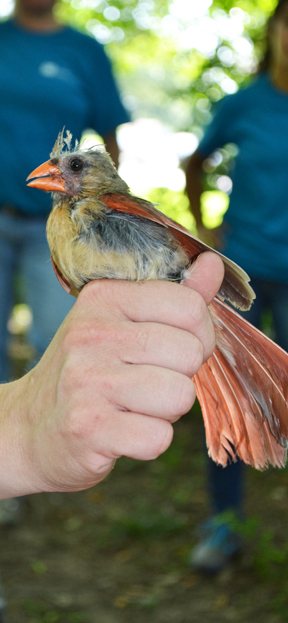
Female cardinal who has just been banded during day two of the Prairie Research Institute Science Camp.
Ever put the pedal to the metal driving a go-cart that runs on biofuel? Or hold a wild female cardinal (who has a stick tightly clenched in her beak, so she won't peck you)? Or learn how archaeologists analyze centuries-old bones? These are just a few of the exciting things twelve high school students got the opportunity to experience while participating in the inaugural run of the Prairie Research Institute Science Camp the week of July 15–19.
While showcasing the important research that takes place in the five state scientific surveys (see below) that comprise the Prairie Research Institute (PRI), a number of the Institute's enthusiastic researchers were delighted to dedicate a day to show the students what they do, as well as expose them to the kinds of careers available in the natural sciences.
According to the camp's Assistant Director, Beth Luber, the event gave PRI researchers, who are passionate about their work, the chance to "pass the baton" on to the next generation.
"Many of our scientists really like to share their enthusiasm for their fields, so this gives them just another opportunity to share it with someone who is going to be the future scientist, the future decision maker…All of our scientists are very excited. They already started planning before the camp was even in go mode."
Nancy Holm, Camp Director, agrees that PRI staff found it to be extremely rewarding.
"The staff teaching the various sessions were also very enthusiastic and were excited to be part of the camp and thought it was a great idea and a good way to engage students and help them see the many possibilities of careers in a variety of sciences. Many staff said they are looking forward to doing the camp again."
Comprised of the following surveys, the Prairie Research Institute addresses a wide range of research in the natural sciences:
- Illinois Natural History Survey
- Illinois State Archaeological Survey
- Illinois State Geological Survey
- Illinois State Water Survey
- Illinois Sustainable Technology Center
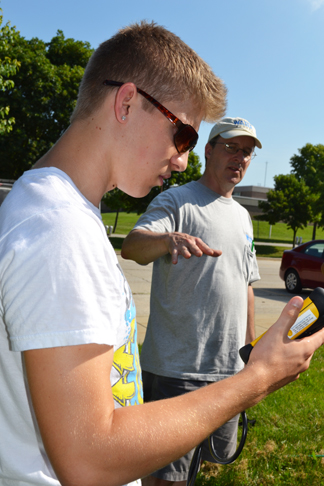
High School student Chieli Moldonado (left) reads the equipment during one of Wednesday's hands-on activities, as Walt Kelly (right) from the Illinois State Water Survey teaches campers how to analyze a water sample they have just taken from a well.
Each day of the camp, students were taught by researchers from one of the five different surveys, who introduced them to their research. The camp was intended to give the students an overview of what natural scientists do in hopes that some of them might choose careers in one of the fields:
"Our goals for the camp," indicates Luber, "were to expose high school students to a wide variety of careers in science and to encourage them to pursue science courses and careers—especially those in the areas of geology, archaeology, natural history, environmental chemistry, and environmental and sustainable engineering."
Did the camp successfully achieve this goal? Camp Director Holm believes so.
"The students indicated the camp helped them see possibilities in other science areas, helped them see what was involved with being a geologist, archeologist, etc. They liked interacting with the scientists and having them answer their questions about classes they had taken and their majors in college, career paths, etc."
Hands-on learning was an important emphasis of the camp. Explains Luber: "We also wanted to give the opportunity for the students to experience these diverse topics with hands-on activities to create concrete connections between the science and real-world applications."
She adds that another goal was to make the camp low cost, plus offer scholarships so low-income students might be able to attend.
A final goal was to expose students to unique topics they might not get in school, as well as interdisciplinary research: "We hope the camp will provide the students with a chance to discuss ideas and concepts not taught in traditional schooling…and show how many issues need an interdisciplinary approach to research to be solved."
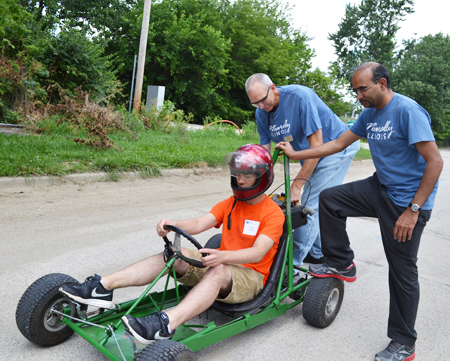
Anxious to reach the checkered flag, a PRI camper (seated on the go-cart), gets an assist from Illinois Sustainable Technology Center research engineers Joe Pickowitz (center) and B. K. Sharma (right) to get rolling.
Tapping into their creativity, the PRI scientists definitely came up with some engaging hands-on activities that most students never experience in school.
For instance, on Monday, the students met B. K. Sharma from the Illinois Sustainable Technology Center. Sharma's reason for doing the camp? "We want to make the next generation ready," he indicates, "make them acquainted with what the challenges are in terms of fuels, so that they can come up with new kinds of biofuels."
So he and his team introduced the students to research about biofuels, teaching them about ethanol and biodiesel, and showing them the differences in the fuel properties, such as how much energy the fuels produce. After touring a reactor where researchers convert the campus' waste cooking oil into biodiesel, the students harnessed the power of this biodiesel during a cruise in a go-cart.
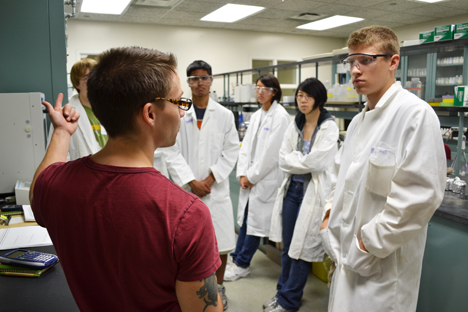
Chieli Maldonado (right) and several other campers listen as grad student Derek Varden (bottom left) explains about some of the research done in the ISTC's labs.
(After this reporter admitted, "The go-cart was a bit slow for my taste," asking if they're working to make a higher octane biodiesel, Sharma was quick to jump to his go-cart's defense, indicating it can reach speeds of 40 mph in the right venue).
Does Sharma think any of the students will end up in the field of biofuels research? "I'm sure," he asserts. "They enjoyed the whole tour very much, and I'm sure that some of them will contribute to making new biofuels in the future."
Regarding the session, one high schooler, Chieli Maldonado, recognized the importance of biofuel research: "I think it's great. We're learning a lot of new things about biodiesel, biofuel, and how it's approaching a new height, and how it's going to affect all of us in the future. And hopefully, sustainable energy reaches a point to where everybody can use it."

Counselor Allison Moran (center) and several of the students who attended the PRI camp enjoy watching various campers take their turn at on the go-cart.
Another local student, Megan Balgenann, discusses the camp: "It's been fun so far. We've seen a lot of the labs and what they're doing back here. It's kind of smelly, but it seems like they're doing a lot of hard work."
Does Balgenann think she'll end up in one of the natural sciences? "I'm not sure yet," she indicates. "That's why I'm here, just to try to figure stuff out."
One of the camp counselors, Allison Moran, who does curriculum development in Engineering, and will be teaching two courses in the fall, also enjoyed the biofuels session: "Yesterday was really exciting. We got to play with biofuels and ride a go-cart. So that was really cool."
Tuesday was the Illinois Natural History Survey's turn. While driving a go-cart might have seemed a tough act to follow, the INHS's hands-on activity involved holding a female cardinal with a propensity for pecking. During their visit to the Anita Purves Nature Center, students tramped through the woods to observe first-hand how field biologists capture wild birds in a net to band them before releasing them back into the wild.
 Allison Moran holds a female cardinal who has a stick tightly clamped in its beak to ensure that it doesn't clamp onto her finger.
Allison Moran holds a female cardinal who has a stick tightly clamped in its beak to ensure that it doesn't clamp onto her finger.Since the temperature was hovering at 100 degrees, students appreciated the shade of Busey Woods as they traipsed back and forth to check the bird nets. Once they had snared several birds, they returned to base camp to learn from ornithologist Tara Beveroth how to record a bird's weight, wing span, and other data and attach a band with a unique number to the bird's leg. This non-invasive method for studying birds enables researchers to obtain information such as migration habits, bird ranges, longevity, and behavior—all important for conservation studies..
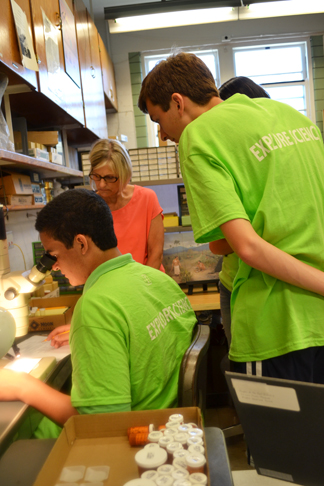
Above and below: Mary Simon, an archaeobotanist from the Illinois State Archaeological Survey (second from the left), instructs several campers about how about how archaeologists analyze artifacts, including using a microscope.
Despite the female cardinal's tendency to peck, Moran couldn't pass up the chance to hold it during the banding process. Moran, who has been a counselor before, but never specifically for a nature camp, appreciated the students' enthusiasm: "They're doing great. They're really smart, and it's really cool to see how excited they're getting about science."
While one of the stated goals of the camp was to encourage students to choose STEM careers, Moran mainly hopes they gain an appreciation for nature. "I'm here just because I want to see kids get excited about science," she acknowledges, "and especially about nature. I think that it's really important for this generation, especially, to get excited about nature and the environment, because some of us grow up so disconnected from it."
Friday's emphasis was archaeology. Working with researchers for the Illinois State Archaeological Survey, students learned how archeologists analyze artifacts, including a hands-on activity working with bones.
Moran was particularly impressed by the quality of the camp's hands-on activities, in general, and the one on Friday in particular.
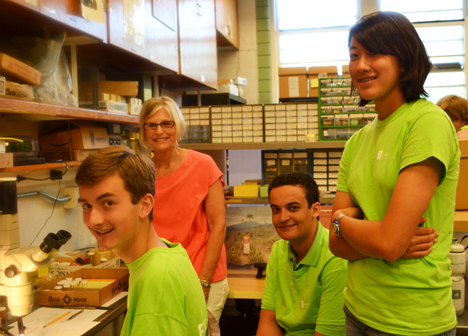
"The best part about it was how realistic and hands on it was. For example, on archaelogy day, the students got to sort through real deer bones that are hundreds of years old. This kind of experience is way more impactful and educational than staring at artifacts inside a glass case. One of the best take-aways that I think they received is the ability to make an educated decision on how enviromental science may fit into their future plans."
According to Moran, the students felt the camp was a positive experience for the campers: "The students LOVED it! I think that they learned a ton from the camp!" Her final assessment: "That camp was incredible!"
Holm was also confident that the students liked it. Her proof? "A number of the students indicated they would like to come back to the camp next summer."
Story and photos by Elizabeth Innes, Communications Specialist, I-STEM Education Initiative.
More: 8-12 Outreach, Summer Camp, 2013
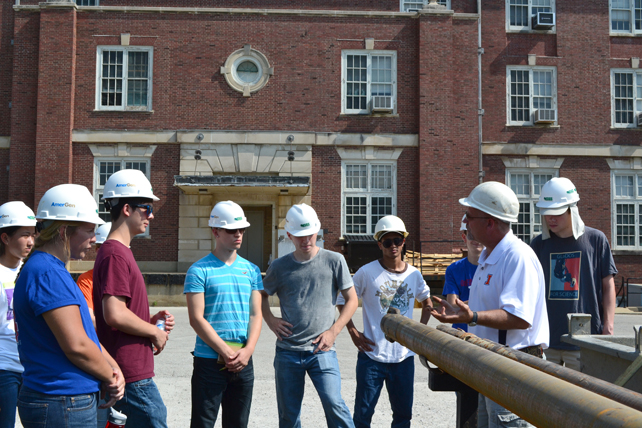
On Thursday, campers learned about how researchers at the Illinois State Geological Survey gather data using a rig and core samples.













.jpg)
















